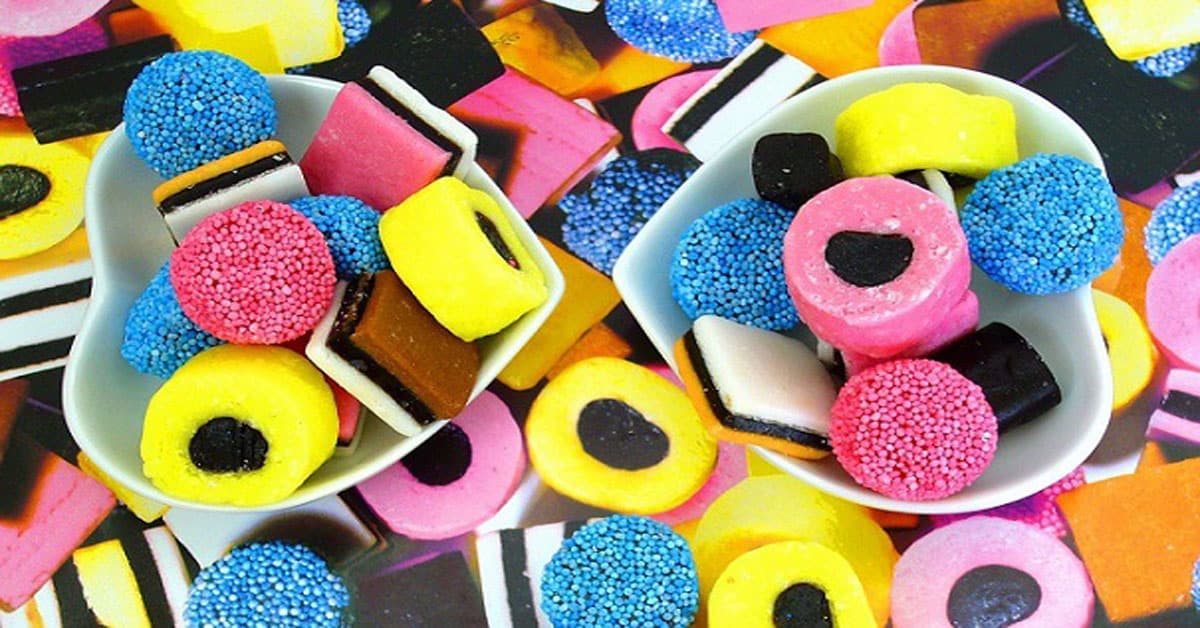Licorice Allsorts – Sweet History Of Colorful Candy Combo
Licorice candy has been loved and adored for generations. That is why the idea of combining different licorice sweets was just what people needed. Liquorice allsorts are a variety of licorice candies that are marketed together. They were created for the first time by Geo. Bassett & Co. Ltd. in Sheffield, England.
If you love and enjoy Licorice Allsorts Candy and want to know more about it, then you are reading the right article. Below, we will explore the history, origin, and tastes of Licorice Allsorts.
Please leave a review or any memories of this snack in the comments at the bottom of this page. Thank you!
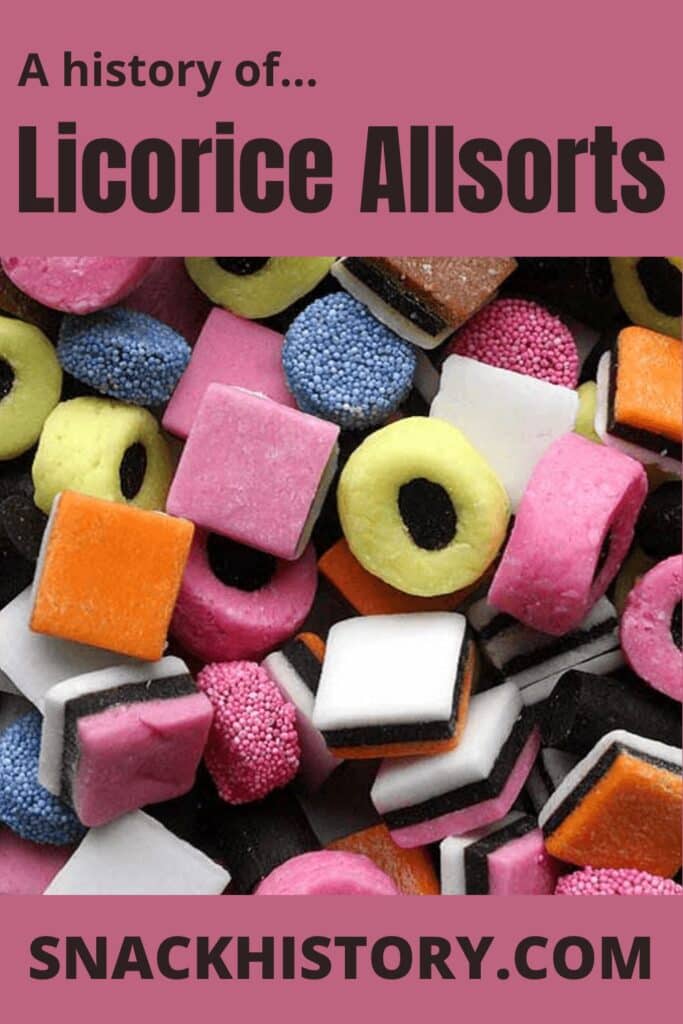
Overview
Many businesses make all sorts of products around the globe, but they are most well-known in Europe. Particularly in Britain and the Netherlands, they are known as Engelse drops or English licorice. Licorice candy is also widespread in Scandinavia. There, they are referred to as “Englantilainen lakritsi” in Finland and “Engelsk konfekt” or “Lakritskonfekt” in Sweden. The product is produced in large amounts by the South African confectionery “behemoth Beacon,” which also sells it domestically and exports it to Australia, Canada, and Portugal.
Licorice sweets are offered in combination with Licorice Allsorts. Liquorice, sugar, coconut, aniseed syrup, berry flavorings, and gelatin are the main ingredients in these sweets. They were first made by Geo. Bassett & Co. Ltd., a division of the Cadbury Corporation, in Sheffield, England.
The Bassett Company asserts that Charlie Thompson, a sales agent, spilled a tray of samples he was displaying to a client in 1899, mingling the different candies. The client was fascinated by the new arrangement, despite his attempts to rearrange them. Under the brand name Allsorts, the business started mass-producing the “novel” product, which quickly gained popularity.
Bassett’s Jelly Babies and Licorice Allsorts are sold on Amazon in a bundle known as the Bassett’s Bundle. If the shipment cost and expected mailing time of the bundle are reasonable, the combination would be an excellent way to enjoy the candies. Those candies can also be found in numerous local supermarkets and convenience stores.
Flavors
Thompson’s initial mixture included chips, pebbles, rivets, nuggets, plugs, and twists. Today, it is unclear which, if any, correlates to Bassets’ current Licorice Allsorts. Newer products, like the Bertie, have undoubtedly been introduced since the original versions.
Some allsorts brands don’t contain licorice, despite the term “Licorice Allsorts.” However, they do have black sections similar to the original ones. They might contain anise (or anise seed). It is a naturally occurring material with a flavor reminiscent of licorice.
Two varieties of Allsorts flavors from Bassett’s are available, but they have no licorice content. Dessert Allsorts have flavors like apple pie and lemon cheesecake, while Fruit Allsorts have candies with mixed-fruit flavors. Both still have the candy’s unique forms and textures. A short time later, in the late 1990s, red allsorts with fruit-flavored licorice were abandoned and then returned to the UK in flavors like Blueberry Cube, Strawberry Check, and red licorice “Betty Bassett.”
The variations of Licorice Allsorts candies are a sandwich consisting of two layers of pink, orange, brown, or white candies with a layer of black, licorice-flavored candy in the center.
The second variation is a black, licorice-flavored cylinder in the middle, surrounded by a short, pink, or yellow, coconut-flavored cylinder.
A round and long white confectionery cylinder and a long, black, licorice-flavored cylinder are also available. A flat, spherical, pink or blue sweet enclosing a gelatinous, anise-flavored center is another delicious combination found in the Licorice Allsorts sweets.
Coconut & Licorice
The coconut type of Licorice Allsorts is a favorite of many people, but it always seems to be the least common in the package. The fortunate winner in the candy lotto is the one who receives a coconut Licorice Allsorts (without first glancing at their candy pick).
Licorice Allsorts in Pop Culture
The Kandyman, an enemy from the Doctor Who television serial episode “The Happiness Patrol,” formed of Licorice Allsorts and likened to Bertie Bassett by some, was a villain. The BBC assured Bassett’s that the Kandyman would not reappear despite an internal inquiry finding that the show had not violated their trademark.
In 2001, Bertie Bassett made an appearance in a brief sequence in a newspaper with the title “Bassett’s Allsorts” in the satirical film Mike Bassett: England Manager.
A Guinness World Record for the biggest Licorice Allsort was achieved in 2016 by RJ’s Licorice of New Zealand. The lime green and black sandwich had the same proportions of height, breadth, and depth as a genuine Licorice Allsorts. The sweets weighed 2,436 pounds or 1,105 kilograms. The confectionery was divided into parts and given out for consumption after the record was verified.
Mascot
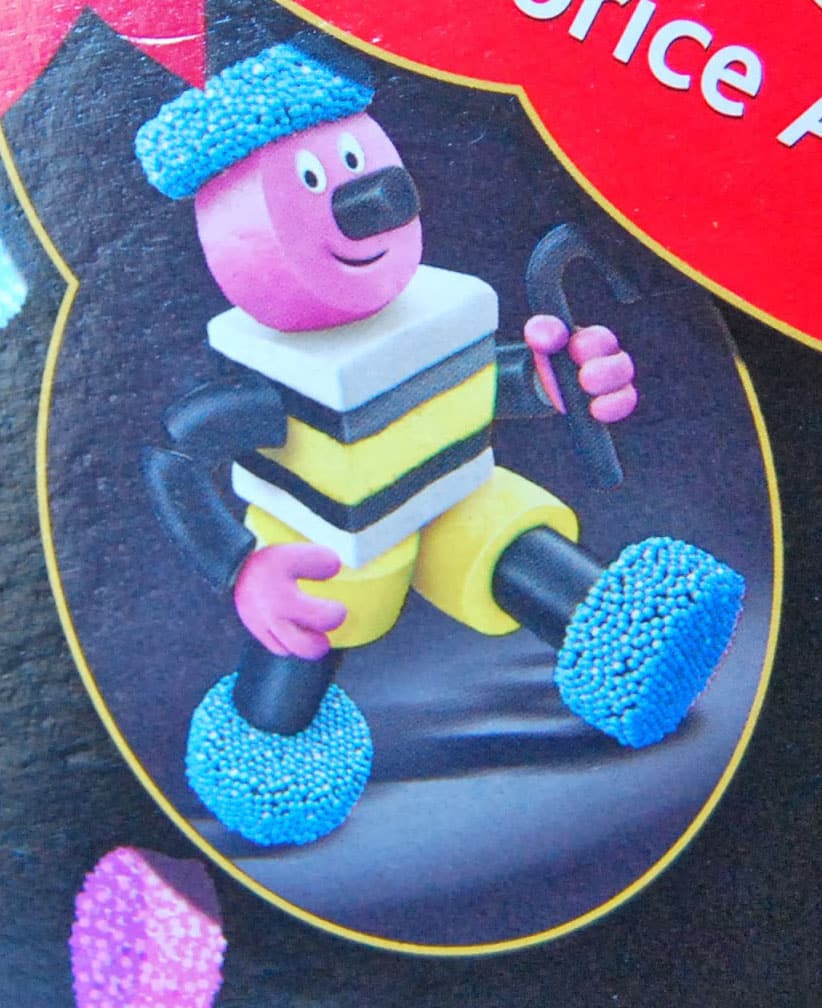
Bertie Bassett, a character formed of Licorice Allsorts that has entered British popular culture, serves as the corporate symbol for The Bassett. Advertising designer Frank Regan created the original Bertie using a variety of pipe cleaners and candies. Regan is credited with creating the figure. A licorice figurine in the form of Bertie is one of the candies in the contemporary allsorts combination. Today, a package of UK Licorice Allsorts includes a solitary piece of soft confectionery fashioned like Bertie Bassett. It is rumored that this particular one has a true licorice flavor.
Since 1929, Bertie has served as the company’s symbol and has gained notoriety. As a marketing ploy for Bassett’s, Bertie married Betty, who is another popular candy mascot with a torso constructed of Licorice Allsorts, in 2009. The idea’s originators presumably believed that it would stick in consumers’ minds and serve as a reminder of the product. They might have been correct. At its Sheffield plant in February 2009, Bassett’s held a fake wedding between those two mascots.
Bassett Candy Company
George Bassett founded The Bassett’s Confectionery Company in Sheffield, England, in 1842. He was born in 1818 and died in 1886. He had previously served as Sheffield’s mayor.
Bassett hired Samuel Meggitt Johnson as an assistant in 1851. Johnson subsequently married Bassett’s daughter. Until Gordon Johnson stepped down as chairman in the 1970s, his heirs managed the business. In 1929, Bassett’s debuted on the London Stock Exchange. In 1852, they established a plant in Sheffield’s Broad Street. In 1933, the location was transferred to Owlerton, a different area of the city, and it is still there today.
Jelly Babies and Licorice Allsorts were created after the death of George Bassett in the nineteenth century, particularly in the North West of England.
In 1992, the Trebor business acquired Bassett’s. Later, the Cadbury Schweppes corporation bought Trebor. Bassett’s goods are now sold under the name Mondelez International, which Kraft founded after purchasing Cadbury. The business has global operations while having its base in Chicago. The Bassett brand can still be found on Jelly Bellies and Licorice Allsorts.
Jelly Babies
Alongside Licorice Allsorts, Bassett’s candy brand was also one of the first companies to manufacture Jelly Babies. It’s unclear when Jelly Babies first appeared. They might have first surfaced around 1864 when an English confectionery firm requested a worker to design a mold for jelly bears.
The sweets were referred to as “unclaimed babies” because it seems that the mold resembled a newborn more than a bear. The phrase “unclaimed babies” was then used to describe infants left outside of buildings. Even though the notion of using the word to describe a candy disturbs us today, it appears to have been permissible in the 19th century. Advertisements from the past indicate that the general public purchased sweets under this moniker.
According to a well-known but unproven rumor, Bassett’s produced the predecessor to their jelly babies in 1918 under the name “peace infants” to commemorate the conclusion of World War I. The item was reintroduced as Jelly Babies in 1953.
Although the exterior of Bassetts’ Jelly Babies is harder than the inside, they are soft sweets. They don’t have the same rubbery feel as gummy sweets from North America. They are simple to digest, making it easy to consume excessive amounts of them. There is a starch coating on top of the sweets.
Depending on the jelly baby’s maker and the nation in which it is distributed, different ingredients may be used. Typically, gelatin, sugar, citric acid, water, flavors, and colors are used to make them.
History of Licorice Flavor
Although licorice flavor has long been a favorite, Liquorice Allsorts have only been adorning our candy shelves for the past century or so. The sweet root was particularly beloved by the Ancient Egyptians, and archaeologists even discovered some inside King Tutankhamun’s sarcophagus.
Consumers must confirm whether there is true licorice in their preferred brand of Licorice Allsorts. The real licorice material is taken out of the licorice plant’s root. Although it presumably does not have any advantages when combined with sugar and the other components in Licorice Allsorts, it can be quite healthy. A balance in amount is essential; otherwise, it may contain risks. It includes glycyrrhizin, a compound that could cause blood pressure to rise.
Licorice Allsorts Logo
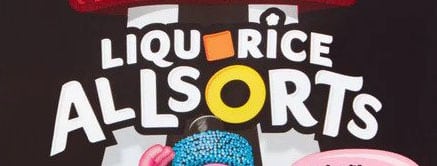
Ingredients
- Sugar
- Molasses
- Glucose Syrup (contains Sulphites)
- Wheat Flour (With added Calcium, Iron, Niacin, and Thiamin)
- Desiccated Coconut
- Starch
- Gelatine
- Colors (Plain Caramel, Beetroot Red, Curcumin, Vegetable Carbon, Paprika Extract, Anthocyanins, Lutein)
- Fat-Reduced Cocoa Powder
- Liquorice Extract
- Flavorings
- Vegetable Oils (Palm Kernel, Coconut, Sunflower)
- Caramel Sugar Syrup
- Glazing Agent (Carnauba Wax)
- Concentrated Vegetable Extract (Spirulina)
Nutrition
| Serving Size: | 3 pieces (40g) | % Daily Value* |
| Amount Per Serving | ||
| Calories | 150 | |
| Calories from Fat | 10 | |
| Total Fat | 1g | 2% |
| Saturated Fat | 1g | 5% |
| Trans Fat | 0g | |
| Cholesterol | 0mg | 0% |
| Sodium | 15mg | 1% |
| Total Carbohydrates | 34g | 11% |
| Dietary Fiber | 0.5g | 2% |
| Sugars | 28g | |
| Protein | 1g | |
| Vitamin A | 0% | |
| Vitamin C | 0% | |
| Calcium | 1.4% | |
| Iron | 2% |
- Percent Daily Values are based on a 2000-calorie diet.
Pictures
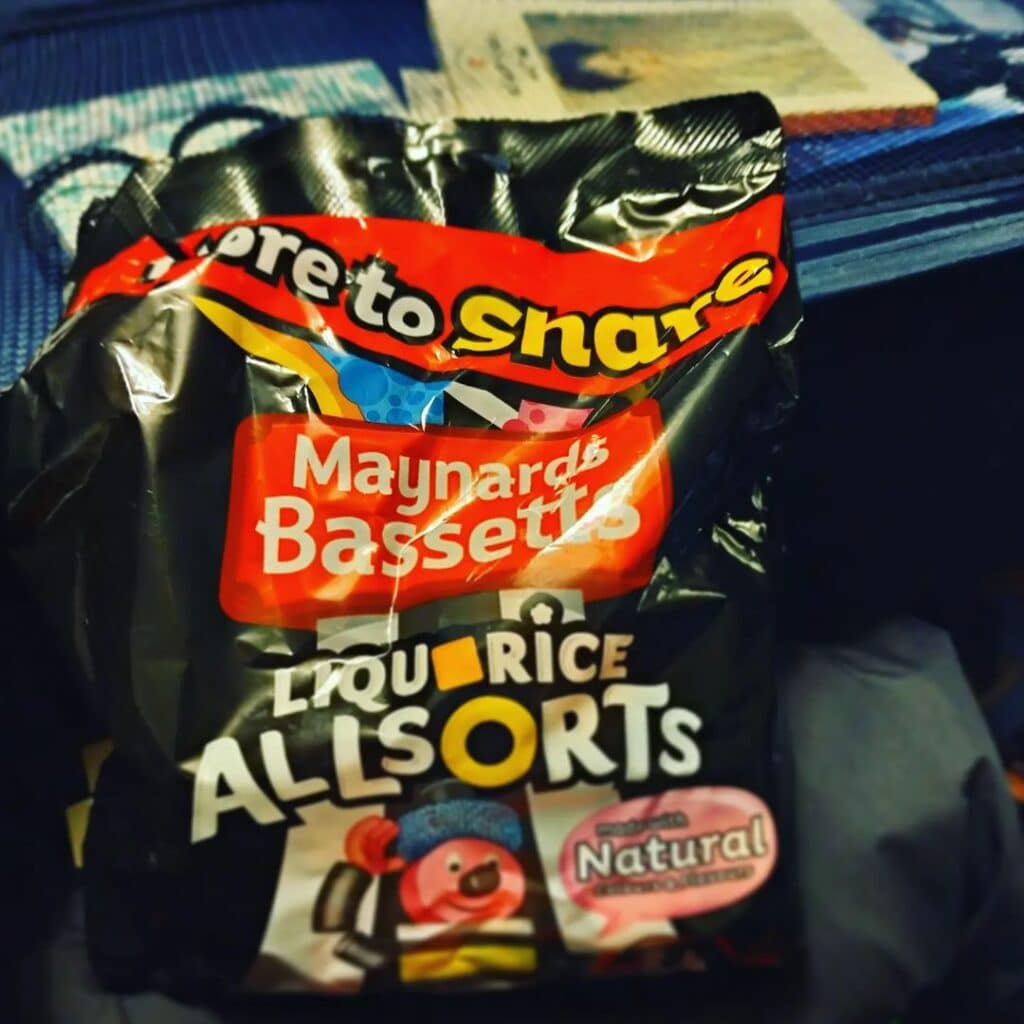
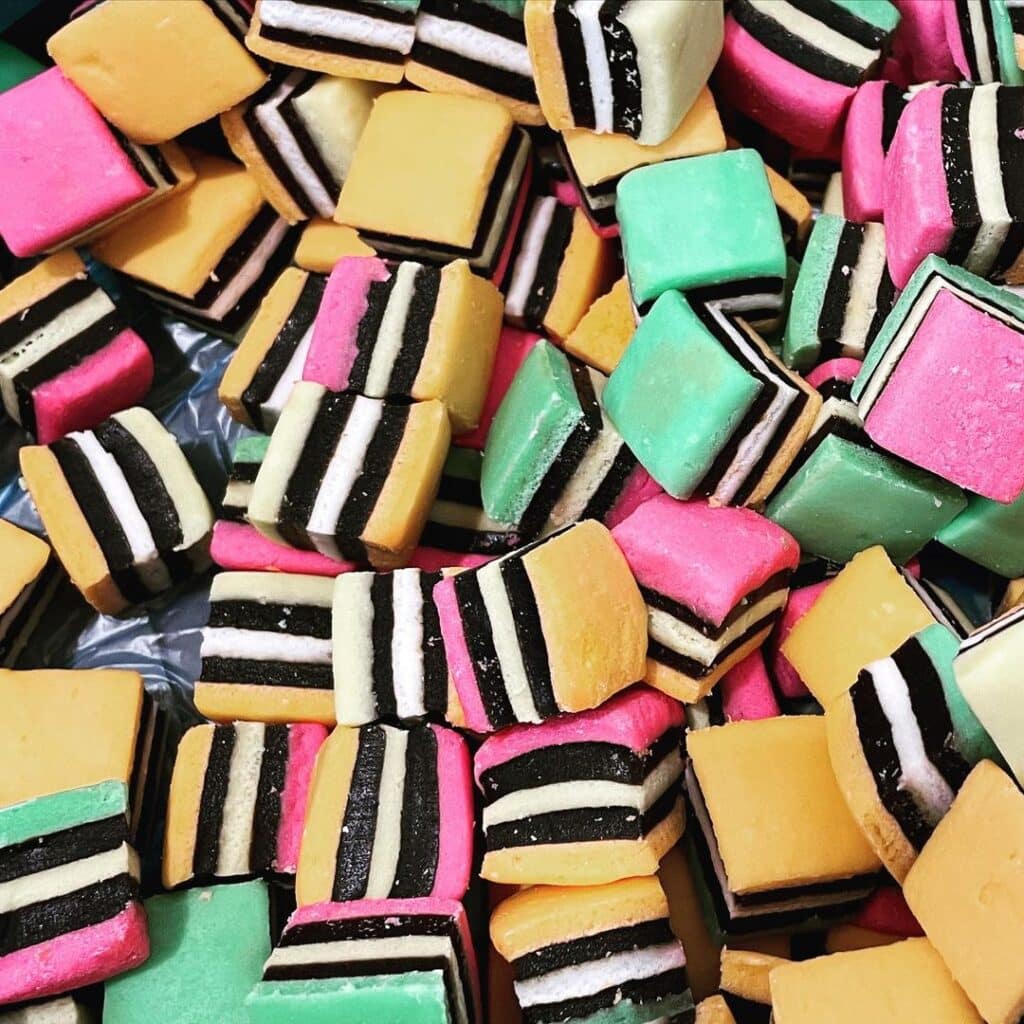
Commercials
Bottom Line
Licorice Allsorts are distinct from other candies on the market, utterly delectable, and unmatched. Those sweets have developed into a popular delicacy that is loved by people around the world. They are more substantial, vividly colored sweets that come in various shapes. Their “allsorts” moniker derives from the variations that this sweet combo includes. The Licorice Allsorts is one of the world’s must-try candies.

Nato is a content writer and researcher with a background in psychology. She’s passionate about writing about the candy industry and exploring the cultural significance of sweets and treats. She believes that the stories behind our favorite snacks can reveal a great deal about our values.
Please leave a review or any memories of this snack in the comments below. Thank you!
Click here for a full A-Z list of Snacks and Candy
